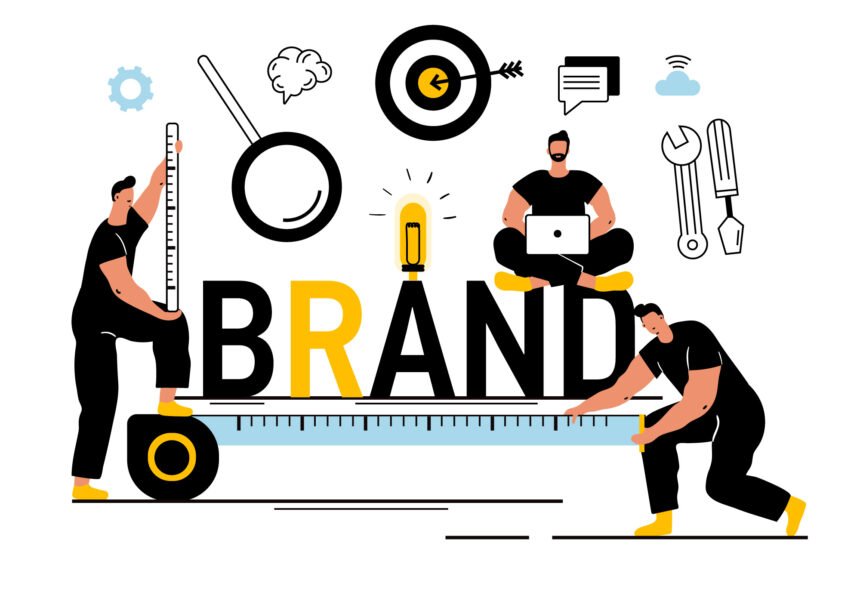Why Relevance Is Everything
In an age of short attention spans, shifting consumer behavior, and algorithm-driven marketing, remaining relevant isn’t optional—it’s essential for survival. According to a 2024 report by Edelman, 81% of consumers need to trust a brand to consider buying from it, and brand trust is built through consistent, relevant experiences over time.
Yet, many businesses treat branding as a one-time design project instead of an evolving strategy. In 2025, branding is not just about standing out visually—it’s about staying emotionally and culturally aligned with your audience.
What Branding Really Means Today
Branding has evolved from logos and slogans to a comprehensive ecosystem of identity, values, perception, and customer experience. It is the sum total of how your business is perceived across every touchpoint—visual, verbal, digital, and emotional.
Core Aspects of Branding in 2025:
- Brand Purpose: Why your company exists beyond making a profit.
- Brand Identity: Visual assets such as logos, fonts, colors, and packaging.
- Brand Voice and Tone: The style in which you communicate across platforms.
- Brand Experience: Every interaction a customer has with your business, from ads to customer service.
- Brand Reputation: What people say about you when you’re not in the room.
Why it matters:
According to Lucidpress, brands with consistent brand presentation see a 33% increase in revenue compared to inconsistent brands.
Why Branding Is the Key to Staying Relevant
Relevance in today’s market requires more than marketing. Consumers expect brands to evolve with them, not just advertise to them. Branding allows you to adapt while remaining recognizable.
1. Branding Creates Differentiation
In highly saturated markets, branding provides your edge. Products and services can be copied. Your brand experience cannot.
- Stat: A Nielsen global survey found that 59% of consumers prefer to buy new products from brands they are familiar with.
- Branding builds familiarity, which leads to trust, which leads to repeat purchases.
2. Branding Builds Trust and Loyalty
A consistent brand image and message make your company feel more trustworthy. Trust is the foundation for long-term relevance.
- Stat: According to PwC, 73% of consumers cite experience as an important factor in their purchasing decisions, yet only 49% say companies provide a good customer experience.
- Branding bridges that gap by aligning expectations with experiences.
3. Branding Helps Navigate Change
- Markets, technologies, and customer values change rapidly. A strong brand gives you the flexibility to evolve without losing identity.
- Brands like Apple, Nike, and Patagonia have reinvented themselves multiple times while staying relevant because their core branding remained intact.
![]()
5 Essential Branding Strategies to Stay Relevant in 2025
1. Define and Lead with Purpose
Purpose-driven brands outperform the market. Your audience wants to know what you stand for—beyond your products.
- Stat: Accenture reports that 62% of consumers want companies to take a stand on current and broadly relevant issues.
Action Tip: Tie your brand’s mission to real-world values like sustainability, inclusivity, or innovation.
2. Modernize Your Visual Identity—Strategically
Your logo and visuals should reflect today’s design expectations while remaining familiar. This ensures you evolve without alienating your loyal base.
Case Example: Burger King modernized its logo in 2021 for the first time in 20 years—simplifying it while invoking retro nostalgia.
Action Tip: Refresh design elements every 3–5 years to keep your brand visually competitive.
3. Maintain a Consistent Brand Voice Across Channels
Voice is one of the most underrated tools in modern branding. Whether you’re sending emails or creating TikToks, your brand voice should speak the same language.
Stat: Consistent branding across all channels increases revenue by up to 23%, according to Forbes.
Action Tip: Create a brand voice guide and enforce it across all departments—marketing, sales, and customer support.
4. Invest in Brand Experience, Not Just Campaigns
Your brand isn’t just what you say—it’s how customers feel interacting with you.
Stat: 86% of buyers are willing to pay more for a great customer experience (PwC).
Action Tip: Map the full customer journey. Look for disconnects where your brand promise doesn’t align with the actual experience.
5. Be Culturally Aware and Emotionally Intelligent
Relevance requires understanding what matters to your audience today—not last year.
- Monitor trends
- Listen on social media
- Engage with feedback
- Be ready to evolve messaging
Action Tip: Use tools like Google Trends, social listening platforms, and direct surveys to stay connected with shifting audience preferences.
Common Branding Mistakes That Kill Relevance
- Chasing Trends Blindly: Not every trend fits your brand. Trend-chasing without alignment can dilute your identity.
- Inconsistent Messaging: Changing tone across platforms causes confusion and erodes trust.
- Ignoring Feedback: Brands that ignore reviews, DMs, or community input miss critical insights into relevance.
- Lack of Brand Guidelines: Internal confusion often leads to inconsistent customer experiences.
Branding in Action: How Confemedia.com Builds Relevance for Its Clients
At Confemedia.com, branding is viewed as a living system. The agency specializes in helping businesses across industries build brands that evolve without losing essence.
By combining data, storytelling, and design, Confemedia empowers companies to:
- Create emotional connections with their audience
- Scale without losing brand identity
- Improve marketing ROI through clear, consistent messaging
Whether you’re launching a startup or refreshing a legacy brand, Confemedia’s proven process ensures your brand stays relevant and revenue-focused.
Frequently Asked Questions
1. How often should I update my brand identity?
Update design elements every 3–5 years, or sooner if your audience shifts or the market changes dramatically.
2. Is branding more important than performance marketing?
They work hand-in-hand. Branding builds trust, which makes performance marketing more effective and cost-efficient.
3. Can I measure the ROI of branding?
Yes. Look at metrics like:
- Customer retention
- Brand recall
- Repeat purchase rate
- Lifetime value (LTV)
4. What if my branding isn’t working?
Audit your brand messaging, identity, and customer journey. Look for disconnects or misalignment with audience values. Then refine accordingly.
5. Should small businesses invest in branding?
Absolutely. Branding levels the playing field. In fact, a compelling brand story can outperform a larger competitor with a weaker message.
Brand Relevance Is Brand Survival
Staying relevant in 2025 means building a brand that listens, adapts, and connects. Branding is no longer optional—it’s the foundation of growth, trust, and long-term value.
If your brand is struggling to stand out or evolve, it might be time to stop marketing and start branding.
Let Confemedia.com help you transform your business into a brand that lasts. Because in a world of noise, only the clear and consistent are heard.












